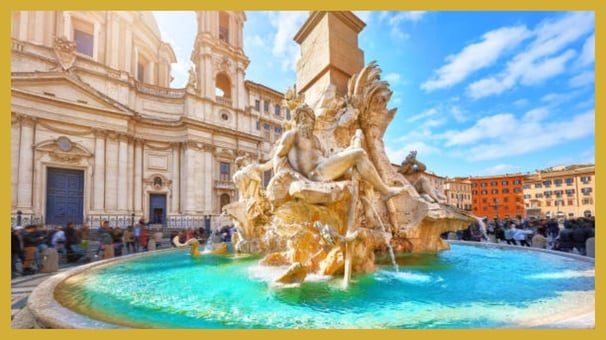Baroque in Rome: The Artistic Expression of Faith and Power
Contents
Rome: Capital of the Baroque
The Baroque Churches: The Example of Sant’Agnese in Agone
Bernini and the Church of the Most Holy Name of Jesus
The Fountain of the Four Rivers: The Baroque in Squares
Conclusion
The Baroque period is unquestionably among the most representative artistic epochs in Rome, a city that breathes its essence in every corner. Its majestic squares and scintillating churches, adorned with opulent embellishments and theatrical sculptures, testify to this rich artistic legacy. Originating in the 17th century, the Baroque was the product of a complex interplay among art, faith, and power, with the Catholic Church playing an integral role. The influence of the Jubilees and a renewed zeal to assert the power of faith through art spurred the creation of formidable works like Bernini's Fountain of the Four Rivers and the Church of Sant’Agnese in Agone. These masterpieces continue to define the city's visage to this day. In Rome's churches, squares, and palaces, the Baroque's theatricality and dramatic expressiveness are vividly showcased, transforming the city into a living architectural treasure. Every corner narrates the saga of an era where art served as a conduit for spiritual messages and authority, captivating and moving all who behold it


Rome: Capital of the Baroque
In the 1600s, Rome emerged as the cradle of the Baroque, ignited by the vision of exceptional artists such as Gian Lorenzo Bernini, Francesco Borromini and Pietro da Cortona, who transformed the city into a hub of artistic innovation. Bernini, for instance, fashioned the colonnade of St. Peter's Square as a symbol of the Church's welcoming embrace and authority; Borromini forged the Church of Sant'Ivo alla Sapienza, marked by its striking spiral dome; while Pietro da Cortona adorned the Palazzo Barberini with a frescoed ceiling reflective of Baroque grandeur and dynamism. During this period, pontiffs like Pope Urban VIII and Pope Alexander VII funded monumental projects to underscore the Church’s pivotal role and to receive pilgrims journeying for the Jubilee.
A paramount example of this transformative era was the erection of St. Peter's Square, with its colonnade masterfully crafted by Bernini to embody a symbolic embrace, welcoming pilgrims globally. Realized for the 1650 Jubilee, this project became an icon of the Church’s spiritual and temporal prowess. Bernini also created numerous other masterpieces in the city, like the Ecstasy of Saint Teresa in the Church of Santa Maria della Vittoria, epitomizing the pinnacle of Baroque art in terms of theatricality and emotive power. This sculpture portrays a moment of mystical ecstasy, its formidable impact transcending the visible, emblematic of the flawless convergence of faith and artistic expression
Roman Baroque was not confined to religious works; it also reshaped the urban landscape of the city. Pope Alexander VII was among the foremost advocates of architectural initiatives, orchestrating the development of new streets and squares to enhance urban traffic flow and establish routes that highlight the significance of sacred sites. The Church of Sant'Ivo alla Sapienza, with its spiral dome and undulating facade, exemplifies how Borromini revolutionized the architecture of the period by merging technical innovation with religious symbolism. Each element of this church was meticulously crafted to evoke a sense of movement and dynamism, turning stone into a visual manifestation of the divine spirit.
Pietro da Cortona, with the ceiling of the Palazzo Barberini, elevated the notions of majesty and grandeur to unparalleled heights. His fresco, The Triumph of Divine Providence, depicts a visual celebration of divine power and will, with figures that appear to emerge from the ceiling and float in space. This glorification of papal power exemplifies the Baroque's intent to astonish and overpower the viewer, creating a sense of wonder that challenges the perception of reality.
The Baroque Churches: The Example of Sant’Agnese in Agone
A quintessential model of Baroque architecture in Rome is the Church of Sant’Agnese in Agone, located in Piazza Navona. Crafted by Francesco Borromini, this church epitomizes the perfect amalgamation of artistic expression and religious devotion. Its concave facade, dominated by the central dome, mirrors the inherent theatricality of the Baroque and seems almost to envelop the spectator. Inside, the interplay of golden stuccoes and frescoes augments the light and shadows, intensifying the sensory experience of the visitors. Piazza Navona itself, with its elliptical contour that recalls the ancient Stadium of Domitian, stands as a stellar example of the Baroque transformation of urban spaces, crafted to awe and amaze passersby.
The artworks within the church, such as the sculptures by Ercole Ferrata and Pier Paolo Campi, manifest the religious fervor and dramatic flair characteristic of Baroque art. The 1650 Jubilee served as a special occasion to promote these masterpieces, which continue to draw global visitors. Baroque's influence stretched beyond the church's confines: Piazza Navona, with Bernini's Fountain of the Four Rivers, transformed into an open-air theater where the church's splendor and the artists' skill converged to create a spectacle of faith and artistry.
Bernini and the Church of the Most Holy Name of Jesus
La Chiesa del Gesù, il fulcro della spiritualità gesuita a Roma, è un altro capolavoro barocco che ebbe un ruolo centrale durante i Giubilei. Fu qui che il Barocco sacro raggiunse uno dei suoi punti più alti. L'interno della chiesa, decorato con affreschi spettacolari di Giovanni Battista Gaulli, detto il Baciccio, rappresenta un'esplosione di gloria divina. L'affresco del soffitto, con la raffigurazione del Trionfo del Nome di Gesù, sembra trascendere i confini fisici della chiesa, aprendo una finestra sul cielo e creando un'illusione di profondità e movimento che cattura lo sguardo dell'osservatore e lo conduce verso il divino.
The Church of the Most Holy Name of Jesus (Chiesa del Gesù), the mother church of the Jesuit order in Rome, represents another Baroque gem integral to the Jubilees. It was here that sacred Baroque achieved one of its zeniths. The interior, adorned with the breathtaking frescoes by Giovanni Battista Gaulli, known as Baciccio, depicts an explosion of divine glory. The ceiling fresco, featuring the Triumph of the Name of Jesus, transcends the physical confines of the church, opening up a celestial window and creating an illusion of depth and movement that captivates the viewer’s gaze and guides it towards the divine
Every day in the Chapel of Saint Ignatius, where the body of Saint Ignatius of Loyola rests, a miracle that has been recurring for centuries unfolds: a true dramatic reveal of the saint who founded the Jesuit Order. This event symbolizes the perpetual devotion of the Jesuits to their founder and their commitment to preserving his spiritual legacy. At around 5:30 pm, amid a symphony of music and dramatic lighting, a curtain rises to unveil a striking bronze statue of Saint Ignatius. This spectacle exemplifies the Baroque art’s mastery in using theatrical elements to captivate the faithful, transforming spirituality into a total sensory experience that touches both heart and mind
Bernini, not only an architect and sculptor, was also a brilliant creator of theatrical spaces, combining architectural and sculptural elements with masterful precision to create works of great emotional impact. His artistic vision extended beyond religious edifices, deeply influencing the entire city. The Scala Regia in the Vatican, a prime example of Bernini's genius, is a pathway that celebrates the power of the Church, transforming an ordinary staircase into a grandiose and solemn experience. Each meticulously crafted detail, from the ethereal light cascading through the windows to the intricately carved ornaments, is deliberately fashioned to awe and inspire reverence among all who tread its path.
The Fountain of the Four Rivers: The Baroque in Squares
Baroque art extended beyond the confines of churches into public spaces. Piazza Navona is an exceptional illustration of how Baroque art forged the urban identity of Rome. Dominating the center of the square is the Fountain of the Four Rivers, commissioned by Pope Innocent X and designed by Gian Lorenzo Bernini, finished in 1651. The fountain portrays four allegorical figures representing the major rivers of the then-known world: the Nile, the Danube, the Ganges, and the Rio de la Plata. Each figure epitomizes a different continent, symbolizing the Church's universal power
This fountain, along with other monumental works created for the Jubilee—like the Column of the Immaculate in Piazza di Spagna—symbolizes the Baroque's ability to fuse spirituality and theatricality, creating spaces that invoke wonder and devotion.
Conclusion
The Baroque movement transformed Rome into a masterpiece of art and architecture, shaped by the Catholic faith and the desire to welcome pilgrims during the Jubilees. Each corner of the city, from the majestic churches to the monumental squares, mirrors the splendor and power of the Catholic Church, which over the centuries has commissioned some of the most renowned works in art history. For those visiting Rome during the Jubilees, exploring the Baroque is not just an artistic journey, but also an unparalleled experience of faith and beauty.
Drop us a line
Follow us
Discover the Jubilee
Experience the Jubilee
Jubilee locations
Get ready for the Jubilee
Rome and the Jubilee
